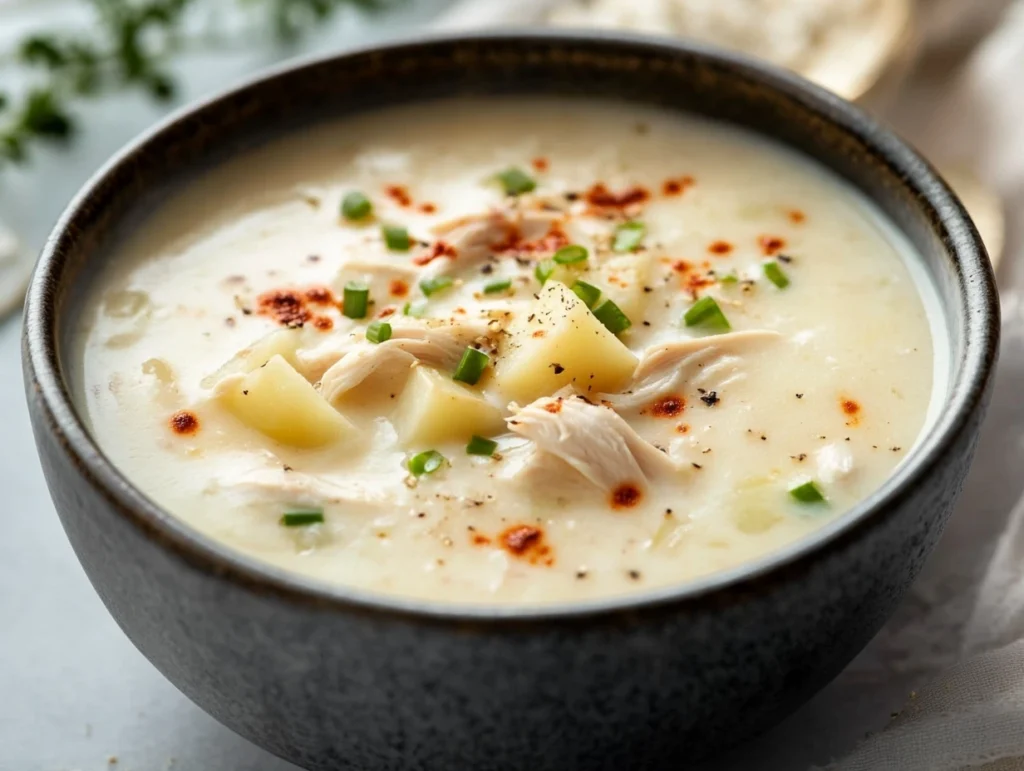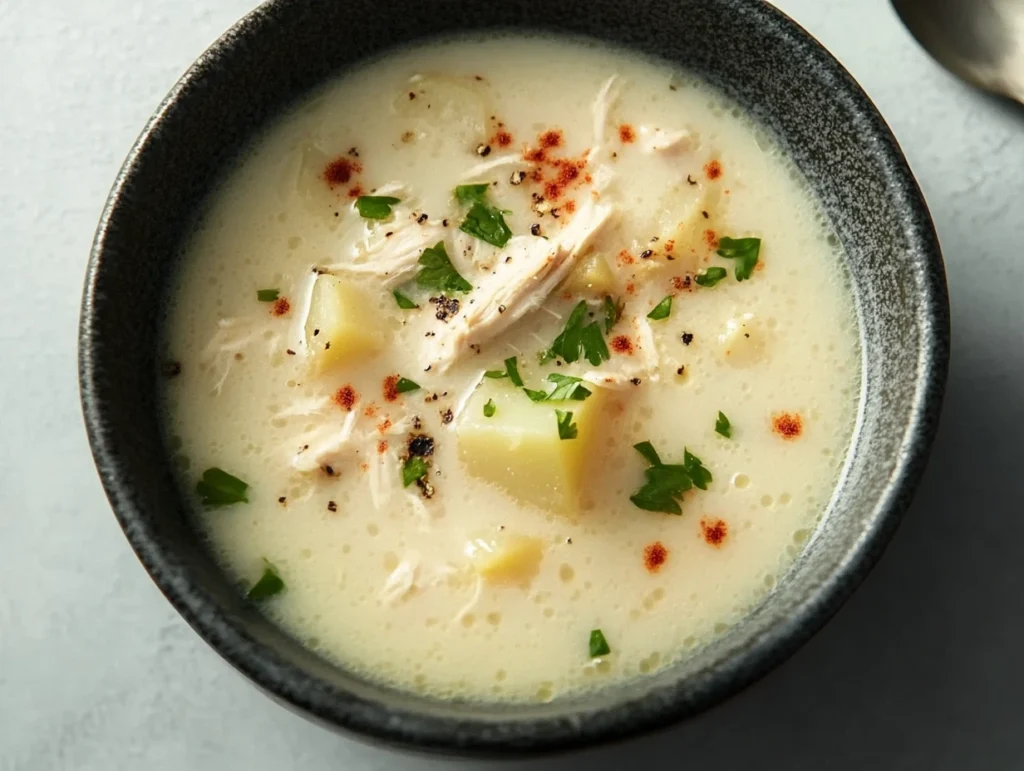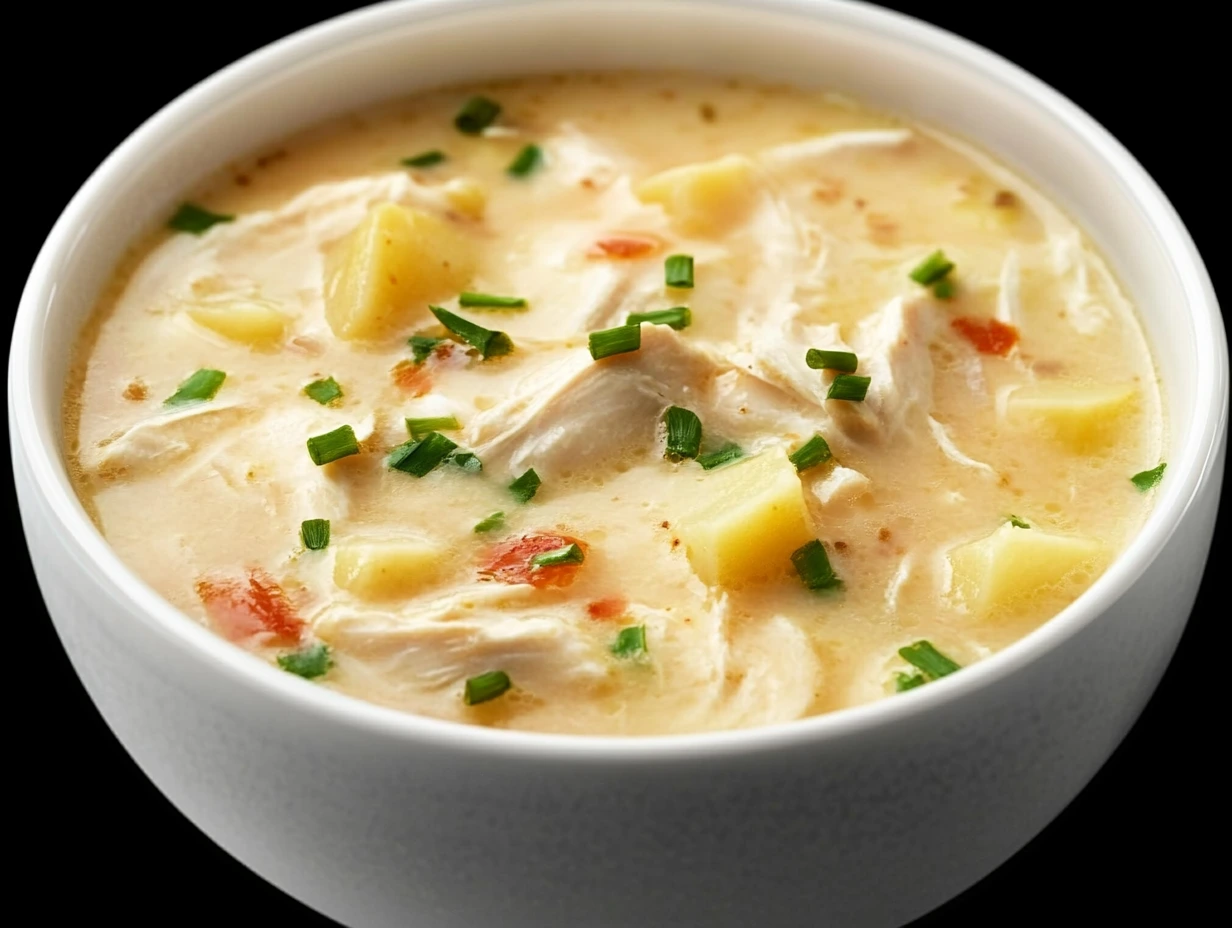Table of Contents
Chicken potato soup recipe is the epitome of comfort food—a hearty, satisfying dish that warms the soul and delights the palate. Perfect for chilly evenings or as a wholesome meal anytime, this soup combines tender chicken, creamy potatoes, and a medley of vegetables and herbs to create a dish that’s as nourishing as it is flavorful. Loved by families and food enthusiasts alike, chicken potato soup is a go-to recipe for its simplicity and universal appeal.

What Is Chicken Potato Soup?
Chicken potato soup is a rich and filling soup made with chunks of chicken, diced potatoes, and a variety of other ingredients like carrots, celery, onions, and spices. Its origins are rooted in traditional home cooking, where simple, accessible ingredients were transformed into comforting meals. Popular across cultures, this soup has earned its place as a staple dish in kitchens worldwide.
Whether prepared as a creamy version with milk or broth-based for a lighter feel, chicken potato soup is celebrated for its versatility and ability to adapt to different tastes. Its popularity lies in its ease of preparation, hearty texture, and the satisfying balance of protein, carbs, and flavors, making it a timeless favorite for all ages.
Key Ingredients and Their Roles
Essential Ingredients
- Chicken:
The heart of the dish, chicken provides protein and a rich, savory flavor. Bone-in chicken adds depth to the broth, while boneless cuts like chicken breasts or thighs offer convenience. - Potatoes:
Potatoes act as the creamy, hearty component. Starchy varieties like russets dissolve slightly to thicken the soup, while waxy types such as Yukon Golds hold their shape better. - Aromatics:
Ingredients like onions, garlic, carrots, and celery form the aromatic base of the soup, adding layers of flavor and fragrance. These are typically sautéed to release their natural sweetness and aroma.
Optional Add-Ins
- Herbs and Spices:
Fresh thyme, rosemary, parsley, or bay leaves infuse the soup with an earthy, herbal aroma. Paprika, cumin, or a pinch of cayenne can add warmth and complexity. - Cream:
A splash of cream or milk turns the soup into a luscious, creamy dish. For a non-dairy option, coconut milk or almond milk works well. - Vegetables:
Add-ins like corn, peas, spinach, or kale enhance the nutritional profile and color of the soup. - Cheese and Bacon:
Shredded cheese or crispy bacon can be used as garnishes to add indulgent, smoky flavors.
Step-by-Step Recipe
1. Preparation
- Chicken: Trim and cut chicken into bite-sized pieces if using boneless cuts. If using bone-in, ensure it’s cleaned and ready for cooking.
- Potatoes: Peel and dice the potatoes into uniform pieces for even cooking.
- Vegetables: Chop onions, carrots, celery, and garlic finely. Prepare any additional add-ins like herbs or leafy greens.
2. Cooking the Base
- Heat a large pot over medium heat and add oil or butter.
- Sauté the onions, garlic, carrots, and celery until softened and fragrant, about 5–7 minutes.
- Season with salt, pepper, and any desired spices to build a flavorful base.
3. Adding Chicken and Potatoes
- Add the chicken to the pot, stirring to coat it in the aromatics. Cook for 5–7 minutes, allowing the chicken to sear slightly.
- Pour in chicken broth or stock, ensuring the ingredients are fully submerged. Bring to a gentle boil.
- Add the diced potatoes and simmer until tender, approximately 15–20 minutes.

Tips for Perfect Chicken Potato Soup
Creating the perfect chicken potato soup is all about attention to detail and balancing ingredients. Here are some essential tips to ensure your soup turns out delicious every time:
1. Use Fresh Ingredients
- Why It Matters: Fresh chicken and produce significantly enhance the flavor and quality of the soup. Fresh vegetables release their natural sweetness and maintain a better texture when cooked, while fresh chicken contributes a rich, savory depth to the broth.
- Pro Tip: Opt for high-quality chicken (preferably organic or free-range) and fresh herbs for the most aromatic and flavorful results.
2. Balancing Flavors
- Why It Matters: A harmonious flavor profile is key to a comforting soup. Overpowering spices or an imbalance of salt can detract from the dish’s natural heartiness.
- How to Achieve It:
- Taste the soup as it cooks and adjust seasoning incrementally.
- Use herbs like thyme or bay leaves for an earthy flavor, and finish with a squeeze of lemon juice or a splash of vinegar for brightness.
- Don’t forget to add salt gradually; it enhances all other flavors without making the dish overly salty.
3. Thickening the Soup
- Why It Matters: The soup’s consistency affects how satisfying it feels. While some prefer a light broth, others enjoy a thicker, creamier texture.
- Techniques:
- Using Potatoes: Starchy potatoes like russets naturally break down during cooking, thickening the soup. Mash a portion of the cooked potatoes and stir them back into the pot for extra creaminess.
- Adding a Roux: A mixture of butter and flour cooked together (roux) can be whisked into the soup for a smooth, thick texture.
- Cream or Milk: For a creamy version, add heavy cream, milk, or a non-dairy alternative in the final few minutes of cooking.
- Blending: Blend a portion of the soup using an immersion blender to achieve a velvety consistency while retaining some chunky bits.
Nutritional Information
Chicken potato soup is not only delicious but also packed with nutrients that make it a balanced meal. Here’s a general breakdown of the nutritional content per serving (based on a 1-cup portion):
- Calories: ~200–300 kcal (varies based on cream or additional ingredients)
- Protein: ~15–20g (from chicken and broth)
- Carbohydrates: ~20–25g (mainly from potatoes)
- Fat: ~8–12g (depends on cream or butter usage)
- Fiber: ~2–4g (from vegetables like potatoes, carrots, and celery)
- Vitamins and Minerals:
- Vitamin C: Supports immune health (from potatoes and herbs).
- Potassium: Aids in muscle function (from potatoes).
- Iron: Essential for oxygen transport (from chicken and broth).
For a lighter version, skip cream or use a non-dairy alternative, and consider reducing the butter or oil.
Common Mistakes and Fixes
1. Overcooking the Chicken
- The Problem: Overcooked chicken becomes tough and stringy, detracting from the soup’s texture.
- The Fix: Use bone-in chicken for a richer broth, or add boneless chicken pieces in the final 15–20 minutes of cooking. Remove and shred them before returning to the soup.
2. Soup Too Thin
- The Problem: A watery soup lacks body and can feel unsatisfying.
- The Fix: Mash or blend a portion of the cooked potatoes, or whisk in a roux (butter and flour mixture) for added thickness.
3. Bland Flavor
- The Problem: Insufficient seasoning leaves the soup tasting dull.
- The Fix: Layer flavors by seasoning as you cook. Add salt and pepper in stages, use fresh herbs, and finish with a splash of acid (lemon juice or vinegar) for brightness.
4. Vegetables Too Mushy
- The Problem: Overcooked vegetables lose their texture and can make the soup unappetizing.
- The Fix: Dice vegetables into uniform pieces and add them at different stages. For example, potatoes may take longer than carrots, so adjust their cooking times accordingly.
5. Soup Too Salty
- The Problem: Over-seasoning can make the soup overwhelming.
- The Fix: Dilute the soup with unsalted broth or water, and add a raw potato to absorb some of the excess salt.
Variations and Customizations
Diet-Friendly Options
- Low-Carb:
- Replace potatoes with low-carb vegetables like cauliflower, turnips, or zucchini.
- Use heavy cream or coconut milk instead of flour-based thickeners.
- Gluten-Free:
- Thicken the soup with cornstarch, arrowroot powder, or mashed potatoes instead of a roux.
- Ensure the chicken broth is labeled gluten-free.
- Dairy-Free:
- Substitute cream or milk with coconut milk, almond milk, or cashew cream for a rich, creamy texture.
- Use olive oil or dairy-free margarine instead of butter.
Flavor Variations
- Spicy Kick:
- Add diced jalapeños, red pepper flakes, or a splash of hot sauce for heat.
- Herb-Infused:
- Enhance the soup with fresh herbs like rosemary, dill, or parsley. Add them toward the end for maximum flavor.
- Cheesy Delight:
- Stir in shredded cheddar, Parmesan, or Gruyère for a creamy, cheesy variation.
- Sprinkle cheese on top just before serving for a melty garnish.
- Mediterranean Twist:
- Add sun-dried tomatoes, spinach, and a pinch of oregano or basil for a Mediterranean-inspired flavor.
- Smoky Flavor:
- Include smoked paprika, chipotle, or smoked sausage for a robust, smoky profile.

How to Serve Chicken Potato Soup
Garnishing Ideas
- Classic Toppings: Sprinkle chopped parsley, chives, or dill for a fresh pop of color and flavor.
- Crunchy Elements: Add croutons, toasted nuts, or crispy bacon bits for texture.
- Creamy Finish: Drizzle cream, yogurt, or a swirl of pesto for an elegant touch.
Pairing Suggestions
- Sides:
- Bread: Serve with crusty bread, garlic bread, or soft dinner rolls to mop up the soup.
- Salads: A light green salad or a tangy coleslaw complements the richness of the soup.
- Grilled Vegetables: Roasted asparagus, zucchini, or carrots make for a balanced side dish.
- Drinks:
- White Wine: A crisp Chardonnay or Sauvignon Blanc pairs well with the creamy flavors.
- Beer: Try a light lager or wheat beer for a casual meal.
- Non-Alcoholic: Lemon-infused water, iced tea, or a refreshing cucumber cooler are great options.
FAQs: Chicken Potato Soup
Here are answers to some of the most frequently asked questions about making and storing chicken potato soup:
1. Should You Boil Potatoes Before Adding Them to Soup?
- Answer: No, it’s not necessary to boil potatoes before adding them to the soup. Diced raw potatoes can be added directly to the simmering broth, where they’ll cook and absorb the flavors of the soup. If you’re in a hurry, parboiling the potatoes can speed up the process, but it may slightly reduce the flavor they contribute.
2. What Is the Secret Ingredient in Soup?
- Answer: The “secret ingredient” often depends on the recipe, but common enhancers include:
- A splash of vinegar or lemon juice at the end to brighten the flavors.
- A small amount of sugar to balance the saltiness and acidity.
- Parmesan rind or a bay leaf for subtle depth during simmering.
- Herbs like thyme or rosemary for a fragrant finish.
3. Do You Cook the Chicken Before Putting It in Soup?
- Answer: Not always. Raw chicken can be added to the soup and cooked directly in the broth, which helps infuse the soup with more flavor. If you’re using leftover or pre-cooked chicken, add it toward the end of cooking to prevent it from becoming overcooked or dry.
4. How to Thicken Chicken Potato Soup?
- Answer: There are several ways to thicken chicken potato soup:
- Mash or Blend: Mash a portion of the cooked potatoes or blend a small portion of the soup and stir it back in.
- Roux: Make a roux by cooking equal parts butter and flour, then whisk it into the soup.
- Cornstarch Slurry: Mix 1–2 tablespoons of cornstarch with cold water, then stir it into the soup and simmer until thickened.
- Cream: Add heavy cream, half-and-half, or coconut milk for a creamy, thick texture.
Chicken potato soup is a versatile and comforting dish that can be customized in countless ways. For a gluten-free variation, you can adapt techniques from chicken slow cooker recipes gluten-free to suit dietary needs. If you’re looking for a hearty side dish to accompany your soup, consider the rich flavors of a green bean potato casserole for a complete meal. Those interested in exploring more protein-packed recipes might enjoy trying a comforting chicken dumpling soup, which shares similar wholesome ingredients.
Conclusion
Chicken potato soup is the perfect combination of comfort and nourishment, offering a hearty meal that suits a variety of tastes and preferences. Whether you stick to the classic recipe or customize it with unique flavors and diet-friendly variations, this dish is a timeless favorite that brings warmth to any table.
By mastering the balance of flavors, using fresh ingredients, and avoiding common mistakes, you can create a soup that’s rich, satisfying, and sure to delight. Pair it with complementary sides and drinks for a complete meal, and enjoy the joy of sharing this wholesome dish with family and friends.

